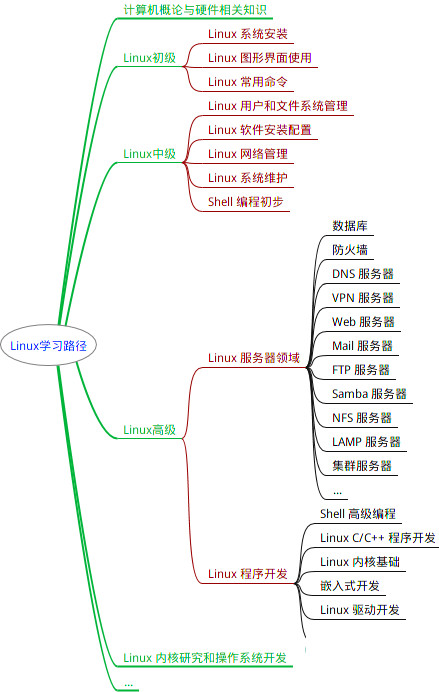
最全的Linux教程,Linux从入门到精通
======================
-
linux从入门到精通(第2版)
-
Linux系统移植
-
Linux驱动开发入门与实战
-
LINUX 系统移植 第2版
-
Linux开源网络全栈详解 从DPDK到OpenFlow

第一份《Linux从入门到精通》466页
====================
内容简介
====
本书是获得了很多读者好评的Linux经典畅销书**《Linux从入门到精通》的第2版**。本书第1版出版后曾经多次印刷,并被51CTO读书频道评为“最受读者喜爱的原创IT技术图书奖”。本书第﹖版以最新的Ubuntu 12.04为版本,循序渐进地向读者介绍了Linux 的基础应用、系统管理、网络应用、娱乐和办公、程序开发、服务器配置、系统安全等。本书附带1张光盘,内容为本书配套多媒体教学视频。另外,本书还为读者提供了大量的Linux学习资料和Ubuntu安装镜像文件,供读者免费下载。

本书适合广大Linux初中级用户、开源软件爱好者和大专院校的学生阅读,同时也非常适合准备从事Linux平台开发的各类人员。
需要《Linux入门到精通》、《linux系统移植》、《Linux驱动开发入门实战》、《Linux开源网络全栈》电子书籍及教程的工程师朋友们劳烦您转发+评论
网上学习资料一大堆,但如果学到的知识不成体系,遇到问题时只是浅尝辄止,不再深入研究,那么很难做到真正的技术提升。
一个人可以走的很快,但一群人才能走的更远!不论你是正从事IT行业的老鸟或是对IT行业感兴趣的新人,都欢迎加入我们的的圈子(技术交流、学习资源、职场吐槽、大厂内推、面试辅导),让我们一起学习成长!
-
7 cron模块
-
8 user模块
-
- 添加一个用户并指定 uid
-
删除用户
-
9 group模块
-
- 建立组并指定gid
-
删除组
-
10 script模块
-
11 setup模块
-
12 service 模块
-
参考
=================================================================
往期Ansible目录
==========================================================================
ansible是新出现的自动化运维工具,基于Python开发,集合了众多运维工具(puppet、chef、func、fabric)的优点,实现了批量系统配置、批量程序部署、批量运行命令等功能。
简单来说ansible是一种架构,本身没有批量部署的能力批量部署能力是由模块来提供的!而且不需要在被控制的主机上安装任何东西,因为ansible是通过ssh协议来与远程主机通讯的
-
部署简单,只需在主控端部署Ansible环境,被控端无需做任何操作;
-
默认使用SSH协议对设备进行管理;
-
有大量常规运维操作模块,可实现日常绝大部分操作;
-
配置简单、功能强大、扩展性强;
-
支持API及自定义模块,可通过Python轻松扩展;
-
通过Playbooks来定制强大的配置、状态管理;
-
轻量级,无需在客户端安装agent,更新时,只需在操作机上进行一次更新即可;

主要模块
-
Ansible:ansible核心程序
-
HostInventory:主机清单,记录由Ansible管理的主机信息,包括端口、密码、ip等。
-
Playbooks:剧本,YAML格式文件,多个任务定义在一个文件中,定义主机需要调用哪些模块来完成的功能。
-
CoreModules:核心模块,主要操作是通过调用核心模块来完成管理任务。
-
CustomModules:自定义模块,完成核心模块无法完成的功能,支持多种语言。
-
ConnectionPlugins:连接插件,Ansible和Host通信使用
工作流程
-
用户使用ansible程序
-
ansible查看主机清单(HostInventory)
-
ansible知道要控制的都有谁了,开始调用模块、剧本或角色
-
通过连接模块连接远程主机,部署任务开始
命令执行过程
-
加载自己的配置文件,默认/etc/ansible/ansible.cfg;
-
查找对应的主机配置文件,找到要执行的主机或者组;
-
加载自己对应的模块文件,如 command;
-
通过ansible将模块或命令生成对应的临时py文件(python脚本), 并将该文件传输至远程服务器;
-
对应生成用户的家目录的.ansible/tmp/XXX/XXX.PY文件;
-
给文件 +x 执行权限;
-
执行并返回结果;
-
删除临时py文件,sleep 0退出;
===========================================================================
参考我的另一篇链接,通过yum来安装ansiblehttps://blog.csdn.net/qq_45714272/article/details/118074528?spm=1001.2014.3001.5501
安装目录如下(yum安装):
配置文件目录:/etc/ansible/
执行文件目录:/usr/bin/
Lib库依赖目录:/usr/lib/pythonX.X/site-packages/ansible/
Help文档目录:/usr/share/doc/ansible-X.X.X/
Man文档目录:/usr/share/man/man1/
ansible 的配置文件为/etc/ansible/ansible.cfg,ansible 有许多参数,下面我们列出一些常见的参数:
inventory = /etc/ansible/hosts #这个参数表示资源清单inventory文件的位置
library = /usr/share/ansible #指向存放Ansible模块的目录,支持多个目录方式,只要用冒号(:)隔开就可以
forks = 5 #并发连接数,默认为5
sudo_user = root #设置默认执行命令的用户
remote_port = 22 #指定连接被管节点的管理端口,默认为22端口,建议修改,能够更加安全
host_key_checking = False #设置是否检查SSH主机的密钥,值为True/False。关闭后第一次连接不会提示配置实例
timeout = 60 #设置SSH连接的超时时间,单位为秒
log_path = /var/log/ansible.log #指定一个存储ansible日志的文件(默认不记录日志)
有多种定义方式:
1、 直接指明主机地址或主机名:
192.168.100.10
2、定义一个组名,把主机加进去,当然也可以用通配符来匹配!
[test]
192.168.100.[1:3]0
…
…
…
“/etc/ansible/hosts” 57L, 1169C 1,1
Ansible执行的时候根据结果会显示为绿色(成功执行),黄色(成功伴随状态改变)和红色(执行失败)等颜色,颜色的显示与changed的状态相关联,并可以在ansible.cfg中进行定制颜色的设定。
=============================================================================
/usr/bin/ansible Ansibe AD-Hoc 临时命令执行工具,常用于临时命令的执行
/usr/bin/ansible-doc Ansible 模块帮助文档
/usr/bin/ansible-galaxy 下载/上传优秀代码或Roles模块 的官网平台
/usr/bin/ansible-playbook Ansible 任务集编排工具
/usr/bin/ansible-pull Ansible远程执行命令的工具,拉取配置而非推送配置(使用较少,海量机器时使用,对运维的架构能力要求较高)
/usr/bin/ansible-vault Ansible 文件加密工具
/usr/bin/ansible-console Ansible基于Linux Consoble界面可与用户交互的命令执行工具
其中,我们比较常用的是/usr/bin/ansible和/usr/bin/ansible-playbook。
[root@ansible ~]# ansible-doc
Usage: ansible-doc [options] [module…]
Options:
-h, --help show this help message and exit # 显示命令参数API文档
-l, --list List available modules #列出可用的模块
-M MODULE_PATH, --module-path=MODULE_PATH #指定模块的路径
specify path(s) to module library (default=None)
-s, --snippet Show playbook snippet for specified module(s) #显示playbook制定模块的用法
-v, --verbose verbose mode (-vvv for more, -vvvv to enable # 显示ansible-doc的版本号查看模块列表:
connection debugging)
–version show program’s version number and exit
例如:
[root@ansible ansible]# ansible-doc -l |grep nginx
nginx_status_info Retrieve information on nginx stat…
nginx_status_facts Retrieve nginx status facts
[root@ansible ansible]# ansible-doc -s nginx_status_info
- name: Retrieve information on nginx status.
nginx_status_info:
timeout: # HTTP connection timeout in seconds.
url: # (required) URL of the nginx status.
命令的具体格式如下:
ansible host-pattern -m 模块名 -a ‘参数’
通过ansible -h查看
[root@ansible ansible]# ansible -h
-a MODULE_ARGS #模块的参数,如果执行默认COMMAND的模块,即是命令参数,如: “date”,“pwd”等等
-k,–ask-pass #ask for SSH password。登录密码,提示输入SSH密码而不是假设基于密钥的验证
–ask-su-pass #ask for su password。su切换密码
-K,–ask-sudo-pass #ask for sudo password。提示密码使用sudo,sudo表示提权操作
–ask-vault-pass #ask for vault password。假设我们设定了加密的密码,则用该选项进行访问
-B SECONDS #后台运行超时时间
-C #模拟运行环境并进行预运行,可以进行查错测试
-c CONNECTION #连接类型使用
-f FORKS #并行任务数,默认为5
-i INVENTORY #指定主机清单的路径,默认为/etc/ansible/hosts
–list-hosts #查看有哪些主机组
-m MODULE_NAME #执行模块的名字,默认使用 command 模块,所以如果是只执行单一命令可以不用 -m参数
-o #压缩输出,尝试将所有结果在一行输出,一般针对收集工具使用
-S #用 su 命令
-R SU_USER #指定 su 的用户,默认为 root 用户
-s #用 sudo 命令
-U SUDO_USER #指定 sudo 到哪个用户,默认为 root 用户
-T TIMEOUT #指定 ssh 默认超时时间,默认为10s,也可在配置文件中修改
-u REMOTE_USER #远程用户,默认为 root 用户
-v #查看详细信息,同时支持-vvv,-vvvv可查看更详细信息
原理

实验
#1.生成私钥
[root@ansible ~]# ssh-keygen
#2.向主机分发私钥
[root@ansible ~]# ssh-copy-id root@192.168.100.10
[root@ansible ~]# ssh-copy-id root@192.168.100.20
=============================================================================
[root@ansible ~]# ansible 192.168.100.10 -m ping
192.168.100.10 | SUCCESS => {
“ansible_facts”: {
“discovered_interpreter_python”: “/usr/bin/python”
},
“changed”: false,
“ping”: “pong”
}
这样就说明我们的主机是连通状态的。接下来的操作才可以正常进行。
shell模块很常用,它可以在远程主机上调用shell解释器运行命令
[root@ansible ~]# head -10 /etc/ansible/hosts
[test]
192.168.100.[1:3]0
[wsr]
192.168.100.10 http_port=81
192.168.100.20 http_port=82
[wsr:vars]
nodename=mail
domainname=edu
[root@ansible ~]# ansible wsr -m shell -a ‘ls -l’
192.168.100.10 | CHANGED | rc=0 >>
total 188
drwxr-xr-x. 2 root root 6 Aug 11 2020 a
-rw-------. 1 root root 1260 Jun 3 2020 anaconda-ks.cfg
-rw-r–r–. 1 root root 0 Aug 11 2020 b
-rw-r–r-- 1 root root 13 Jun 21 04:09 f4
-rw-r–r-- 1 root root 6540 Jun 21 04:22 log.tar.xz
lrwxrwxrwx. 1 root root 17 Jun 20 22:30 selinux -> …/selinux/config
drwxr-xr-x. 2 root root 25 Jun 20 22:08 sh
-rw-r–r-- 1 root root 175412 Jun 22 03:53 vsftpd-3.0.2-25.el7.x86_64.rpm
192.168.100.20 | CHANGED | rc=0 >>
total 188
drwxr-xr-x. 2 root root 6 Aug 11 2020 a
-rw-------. 1 root root 1260 Jun 3 2020 anaconda-ks.cfg
-rw-r–r–. 1 root root 0 Aug 11 2020 b
-rw-r–r-- 1 root root 13 Jun 21 04:09 f4
-rw-r–r-- 1 root root 6516 Jun 21 04:22 log.tar.xz
-rw-r–r-- 1 root root 175412 Jun 22 03:53 vsftpd-3.0.2-25.el7.x86_64.rpm
总结
提示:
这个模块可以直接在远程主机上执行命令,并将结果返回本主机。
命令模块接受命令名称,后面是空格分隔的列表参数。给定的命令将在所有选定的节点上执行。它不会通过shell进行处理,比如$HOME和操作如"<“,”>“,”|“,”;“,”&"工作(需要使用(shell)模块实现这些功能)。
下面来看一看该模块下常用的几个命令:
-
chdir # 在执行命令之前,先切换到该目录 executable # 切换shell来执行命令,需要使用命令的绝对路径
-
free_form # 要执行的Linux指令,一般使用Ansible的-a参数代替。
-
creates # 一个文件名,当这个文件存在,则该命令不执行,可以
用来做判断
- removes # 一个文件名,这个文件不存在,则该命令不执行
[root@ansible ~]# ansible wsr -m command -a ‘chdir=/data ls’
192.168.100.20 | CHANGED | rc=0 >>
file1
file2
file3
for1.conf
for2.conf
for3.conf
httpd.conf
192.168.100.10 | CHANGED | rc=0 >>
file1
file2
file3
for1.conf
for2.conf
for3.conf
httpd.conf
**这个模块用于将文件复制到远程主机,同时支持给定内容生成文件和修改权限等。
其相关选项如下:**
-
src #被复制到远程主机的本地文件。可以是绝对路径,也可以是相对路径。如果路径是一个目录,则会递归复制,用法类似于"rsync"
-
content #用于替换"src",可以直接指定文件的值
-
dest #必选项,将源文件复制到的远程主机的绝对路径
-
backup #当文件内容发生改变后,在覆盖之前把源文件备份,备份文件包含时间信息
-
directory_mode #递归设定目录的权限,默认为系统默认权限
-
force #当目标主机包含该文件,但内容不同时,设为"yes",表示强制覆盖;设为"no",表示目标主机的目标位置不存在该文件才复制。默认为"yes"
-
others #所有的 file 模块中的选项可以在这里使用
其中src,dest,backup,mode用的较多
复制
[root@ansible ~]# touch 2021710
[root@ansible ~]# ansible wsr -m copy -a ‘src=2021710 dest=/data/2021710’
192.168.100.10 | CHANGED => {
“ansible_facts”: {
“discovered_interpreter_python”: “/usr/bin/python”
},
“changed”: true,
“checksum”: “da39a3ee5e6b4b0d3255bfef95601890afd80709”,
“dest”: “/data/2021710”,
“gid”: 0,
“group”: “root”,
“md5sum”: “d41d8cd98f00b204e9800998ecf8427e”,
“mode”: “0644”,
“owner”: “root”,
“size”: 0,
“src”: “/root/.ansible/tmp/ansible-tmp-1625931089.28-8051-80193366038951/source”,
“state”: “file”,
“uid”: 0
}
192.168.100.20 | CHANGED => {
“ansible_facts”: {
“discovered_interpreter_python”: “/usr/bin/python”
},
“changed”: true,
“checksum”: “da39a3ee5e6b4b0d3255bfef95601890afd80709”,
“dest”: “/data/2021710”,
“gid”: 0,
“group”: “root”,
“md5sum”: “d41d8cd98f00b204e9800998ecf8427e”,
“mode”: “0644”,
“owner”: “root”,
“size”: 0,
“src”: “/root/.ansible/tmp/ansible-tmp-1625931089.28-8052-82580429716175/source”,
“state”: “file”,
“uid”: 0
}
权限和备份
[root@ansible ~]# ansible wsr -m copy -a ‘content=“i am bad boy\n” backup=yes dest=/data/2021710 mode=666’
192.168.100.10 | CHANGED => {
“ansible_facts”: {
“discovered_interpreter_python”: “/usr/bin/python”
},
“backup_file”: “/data/2021710.11493.2021-07-10@11:32:39~”,
“changed”: true,
“checksum”: “444281122cde3d31fa394ffe2d29d9a1fa2411f3”,
“dest”: “/data/2021710”,
“gid”: 0,
“group”: “root”,
“md5sum”: “e2ea0ae0489f588fd0e7adcdc361ff70”,
“mode”: “0666”,
“owner”: “root”,
“size”: 13,
“src”: “/root/.ansible/tmp/ansible-tmp-1625931158.27-8105-89064400502466/source”,
“state”: “file”,
“uid”: 0
}
192.168.100.20 | CHANGED => {
“ansible_facts”: {
“discovered_interpreter_python”: “/usr/bin/python”
},
“backup_file”: “/data/2021710.11427.2021-07-10@11:32:39~”,
“changed”: true,
“checksum”: “444281122cde3d31fa394ffe2d29d9a1fa2411f3”,
“dest”: “/data/2021710”,
“gid”: 0,
“group”: “root”,
“md5sum”: “e2ea0ae0489f588fd0e7adcdc361ff70”,
“mode”: “0666”,
“owner”: “root”,
“size”: 13,
“src”: “/root/.ansible/tmp/ansible-tmp-1625931158.28-8106-201363635505942/source”,
“state”: “file”,
“uid”: 0
}
检测
其中一大串名字的就是备份后的名字,也可以看到权限为666
[root@ansible ~]# ansible wsr -m shell -a ‘ls -l /data’
192.168.100.10 | CHANGED | rc=0 >>
total 32
-rw-rw-rw- 1 root root 13 Jul 10 11:32 2021710
-rw-r–r-- 1 root root 0 Jul 10 11:31 2021710.11493.2021-07-10@11:32:39~
-rw-rw-rw- 1 root root 21 Jul 10 11:20 a.sh
-rw-r–r-- 1 root root 0 Jul 3 23:14 file1
-rw-r–r-- 1 root root 0 Jul 3 23:14 file2
-rw-r–r-- 1 root root 0 Jul 3 23:14 file3
-rw-r–r-- 1 root root 63 Jul 4 11:51 for1.conf
-rw-r–r-- 1 root root 267 Jul 4 12:06 for2.conf
-rw-r–r-- 1 root root 171 Jul 5 04:05 for3.conf
-rw-r–r-- 1 apache root 11753 Jul 10 03:21 httpd.conf
192.168.100.20 | CHANGED | rc=0 >>
total 32
-rw-rw-rw- 1 root root 13 Jul 10 11:32 2021710
-rw-r–r-- 1 root root 0 Jul 10 11:31 2021710.11427.2021-07-10@11:32:39~
-rw-rw-rw- 1 root root 21 Jul 10 11:20 a.sh
-rw-r–r-- 1 root root 0 Jul 3 23:14 file1
-rw-r–r-- 1 root root 0 Jul 3 23:14 file2
-rw-r–r-- 1 root root 0 Jul 3 23:14 file3
-rw-r–r-- 1 root root 63 Jul 4 11:51 for1.conf
-rw-r–r-- 1 root root 267 Jul 4 12:06 for2.conf
-rw-r–r-- 1 root root 171 Jul 5 04:05 for3.conf
-rw-r–r-- 1 apache root 11753 Jul 10 03:21 httpd.conf
通过yum装包
其选项如下:
-
name= #所安装的包的名称
-
state= #present—>安装, latest—>安装最新的, absent—> 卸载软件。
-
其余不常用的就不列举了
安装
state默认为present
[root@ansible ~]# ansible wsr -m yum -a ‘name=vim’
192.168.100.20 | CHANGED => {
“ansible_facts”: {
“discovered_interpreter_python”: “/usr/bin/python”
},
“changed”: true,
“changes”: {
“installed”: [
“vim”
]
},
“msg”: “Repository base is listed more than once in the configuration\nRepository updates is listed more than once in the configuration\nRepository extras is listed more than once in the configuration\nRepository centosplus is listed more than once in the configuration\nRepository epel is listed more than once in the configuration\nRepository epel-debuginfo is listed more than once in the configuration\nRepository epel-source is listed more than once in the configuration\n”,
“rc”: 0,
“results”: [
“Loaded plugins: fastestmirror\nLoading mirror speeds from cached hostfile\nResolving Dependencies\n–> Running transaction check\n—> Package vim-enhanced.x86_64 2:7.4.629-8.el7_9 will be installed\n–> Finished Dependency Resolution\n\nDependencies Resolved\n\n================================================================================\n Package Arch Version Repository Size\n================================================================================\nInstalling:\n vim-enhanced x86_64 2:7.4.629-8.el7_9 updates 1.1 M\n\nTransaction Summary\n================================================================================\nInstall 1 Package\n\nTotal download size: 1.1 M\nInstalled size: 2.2 M\nDownloading packages:\nRunning transaction check\nRunning transaction test\nTransaction test succeeded\nRunning transaction\n Installing : 2:vim-enhanced-7.4.629-8.el7_9.x86_64 1/1 \n Verifying : 2:vim-enhanced-7.4.629-8.el7_9.x86_64 1/1 \n\nInstalled:\n vim-enhanced.x86_64 2:7.4.629-8.el7_9 \n\nComplete!\n”
]
}
192.168.100.10 | CHANGED => {
“ansible_facts”: {
“discovered_interpreter_python”: “/usr/bin/python”
},
“changed”: true,
“changes”: {
“installed”: [
“vim”
]
},
“msg”: “Repository base is listed more than once in the configuration\nRepository updates is listed more than once in the configuration\nRepository extras is listed more than once in the configuration\nRepository centosplus is listed more than once in the configuration\nRepository epel is listed more than once in the configuration\nRepository epel-debuginfo is listed more than once in the configuration\nRepository epel-source is listed more than once in the configuration\n”,
“rc”: 0,
“results”: [
“Loaded plugins: fastestmirror\nLoading mirror speeds from cached hostfile\nResolving Dependencies\n–> Running transaction check\n—> Package vim-enhanced.x86_64 2:7.4.629-8.el7_9 will be installed\n–> Finished Dependency Resolution\n\nDependencies Resolved\n\n================================================================================\n Package Arch Version Repository Size\n================================================================================\nInstalling:\n vim-enhanced x86_64 2:7.4.629-8.el7_9 updates 1.1 M\n\nTransaction Summary\n================================================================================\nInstall 1 Package\n\nTotal download size: 1.1 M\nInstalled size: 2.2 M\nDownloading packages:\nRunning transaction check\nRunning transaction test\nTransaction test succeeded\nRunning transaction\n Installing : 2:vim-enhanced-7.4.629-8.el7_9.x86_64 1/1 \n Verifying : 2:vim-enhanced-7.4.629-8.el7_9.x86_64 1/1 \n\nInstalled:\n vim-enhanced.x86_64 2:7.4.629-8.el7_9 \n\nComplete!\n”
]
}
卸载
改变state的状态为absent即可
[root@ansible ~]# ansible wsr -m yum -a ‘name=vim state=absent’
192.168.100.20 | CHANGED => {
“ansible_facts”: {
“discovered_interpreter_python”: “/usr/bin/python”
},
“changed”: true,
“changes”: {
“removed”: [
“vim”
]
},
“msg”: “Repository base is listed more than once in the configuration\nRepository updates is listed more than once in the configuration\nRepository extras is listed more than once in the configuration\nRepository centosplus is listed more than once in the configuration\nRepository epel is listed more than once in the configuration\nRepository epel-debuginfo is listed more than once in the configuration\nRepository epel-source is listed more than once in the configuration\n”,
“rc”: 0,
“results”: [
“Loaded plugins: fastestmirror\nResolving Dependencies\n–> Running transaction check\n—> Package vim-enhanced.x86_64 2:7.4.629-8.el7_9 will be erased\n–> Finished Dependency Resolution\n\nDependencies Resolved\n\n================================================================================\n Package Arch Version Repository Size\n================================================================================\nRemoving:\n vim-enhanced x86_64 2:7.4.629-8.el7_9 @updates 2.2 M\n\nTransaction Summary\n================================================================================\nRemove 1 Package\n\nInstalled size: 2.2 M\nDownloading packages:\nRunning transaction check\nRunning transaction test\nTransaction test succeeded\nRunning transaction\n Erasing : 2:vim-enhanced-7.4.629-8.el7_9.x86_64 1/1 \n Verifying : 2:vim-enhanced-7.4.629-8.el7_9.x86_64 1/1 \n\nRemoved:\n vim-enhanced.x86_64 2:7.4.629-8.el7_9 \n\nComplete!\n”
]
}
192.168.100.10 | CHANGED => {
“ansible_facts”: {
“discovered_interpreter_python”: “/usr/bin/python”
},
“changed”: true,
“changes”: {
“removed”: [
“vim”
]
},
“msg”: “Repository base is listed more than once in the configuration\nRepository updates is listed more than once in the configuration\nRepository extras is listed more than once in the configuration\nRepository centosplus is listed more than once in the configuration\nRepository epel is listed more than once in the configuration\nRepository epel-debuginfo is listed more than once in the configuration\nRepository epel-source is listed more than once in the configuration\n”,
“rc”: 0,
“results”: [
“Loaded plugins: fastestmirror\nResolving Dependencies\n–> Running transaction check\n—> Package vim-enhanced.x86_64 2:7.4.629-8.el7_9 will be erased\n–> Finished Dependency Resolution\n\nDependencies Resolved\n\n================================================================================\n Package Arch Version Repository Size\n================================================================================\nRemoving:\n vim-enhanced x86_64 2:7.4.629-8.el7_9 @updates 2.2 M\n\nTransaction Summary\n================================================================================\nRemove 1 Package\n\nInstalled size: 2.2 M\nDownloading packages:\nRunning transaction check\nRunning transaction test\nTransaction test succeeded\nRunning transaction\n Erasing : 2:vim-enhanced-7.4.629-8.el7_9.x86_64 1/1 \n Verifying : 2:vim-enhanced-7.4.629-8.el7_9.x86_64 1/1 \n\nRemoved:\n vim-enhanced.x86_64 2:7.4.629-8.el7_9 \n\nComplete!\n”
]
}
**该模块主要用于设置文件的属性,比如创建文件、创建链接文件、删除文件等。
下面是一些常见的命令:**
force #需要在两种情况下强制创建软链接,一种是源文件不存在,但之后会建立的情况下;另一种是目标软链接已存在,需要先取消之前的软链,然后创建新的软链,有两个选项:yes|no
group #定义文件/目录的属组。后面可以加上mode:定义文件/目录的权限
owner #定义文件/目录的属主。后面必须跟上path:定义文件/目录的路径
recurse #递归设置文件的属性,只对目录有效,后面跟上src:被链接的源文件路径,只应用于state=link的情况
dest #被链接到的路径,只应用于state=link的情况
state #状态,有以下选项:
directory:如果目录不存在,就创建目录
file:即使文件不存在,也不会被创建
link:创建软链接
hard:创建硬链接
touch:如果文件不存在,则会创建一个新的文件,如果文件或目录已存在,则更新其最后修改时间
absent:删除目录、文件或者取消链接文件
创建文件夹
[root@ansible ~]# ansible wsr -m file -a ‘path=/data/2339 state=directory’
192.168.100.20 | CHANGED => {
“ansible_facts”: {
“discovered_interpreter_python”: “/usr/bin/python”
},
“changed”: true,
“gid”: 0,
“group”: “root”,
“mode”: “0755”,
“owner”: “root”,
“path”: “/data/2339”,
“size”: 6,
“state”: “directory”,
“uid”: 0
}
192.168.100.10 | CHANGED => {
“ansible_facts”: {
“discovered_interpreter_python”: “/usr/bin/python”
},
“changed”: true,
“gid”: 0,
“group”: “root”,
“mode”: “0755”,
“owner”: “root”,
“path”: “/data/2339”,
“size”: 6,
“state”: “directory”,
“uid”: 0
}
创建链接文件
[root@ansible ~]# ansible wsr -m file -a ‘path=/data/2340 src=2339 state=link’
192.168.100.10 | CHANGED => {
“ansible_facts”: {
“discovered_interpreter_python”: “/usr/bin/python”
},
“changed”: true,
“dest”: “/data/2340”,
“gid”: 0,
“group”: “root”,
“mode”: “0777”,
“owner”: “root”,
“size”: 4,
“src”: “2339”,
“state”: “link”,
“uid”: 0
}
192.168.100.20 | CHANGED => {
“ansible_facts”: {
“discovered_interpreter_python”: “/usr/bin/python”
},
“changed”: true,
“dest”: “/data/2340”,
“gid”: 0,
“group”: “root”,
“mode”: “0777”,
“owner”: “root”,
“size”: 4,
“src”: “2339”,
“state”: “link”,
“uid”: 0
}
测试
[root@ansible ~]# ansible wsr -a ‘ls -l /data’
192.168.100.20 | CHANGED | rc=0 >>
total 32
-rw-rw-rw- 1 root root 13 Jul 10 11:32 2021710
-rw-r–r-- 1 root root 0 Jul 10 11:31 2021710.11427.2021-07-10@11:32:39~
drwxr-xr-x 2 root root 6 Jul 10 11:40 2339
lrwxrwxrwx 1 root root 4 Jul 10 11:42 2340 -> 2339
-rw-rw-rw- 1 root root 21 Jul 10 11:20 a.sh
-rw-r–r-- 1 root root 0 Jul 3 23:14 file1
-rw-r–r-- 1 root root 0 Jul 3 23:14 file2
-rw-r–r-- 1 root root 0 Jul 3 23:14 file3
-rw-r–r-- 1 root root 63 Jul 4 11:51 for1.conf
-rw-r–r-- 1 root root 267 Jul 4 12:06 for2.conf
-rw-r–r-- 1 root root 171 Jul 5 04:05 for3.conf
-rw-r–r-- 1 apache root 11753 Jul 10 03:21 httpd.conf
192.168.100.10 | CHANGED | rc=0 >>
total 32
-rw-rw-rw- 1 root root 13 Jul 10 11:32 2021710
-rw-r–r-- 1 root root 0 Jul 10 11:31 2021710.11493.2021-07-10@11:32:39~
drwxr-xr-x 2 root root 6 Jul 10 11:40 2339
lrwxrwxrwx 1 root root 4 Jul 10 11:42 2340 -> 2339
-rw-rw-rw- 1 root root 21 Jul 10 11:20 a.sh
-rw-r–r-- 1 root root 0 Jul 3 23:14 file1
-rw-r–r-- 1 root root 0 Jul 3 23:14 file2
-rw-r–r-- 1 root root 0 Jul 3 23:14 file3
-rw-r–r-- 1 root root 63 Jul 4 11:51 for1.conf
-rw-r–r-- 1 root root 267 Jul 4 12:06 for2.conf
-rw-r–r-- 1 root root 171 Jul 5 04:05 for3.conf
-rw-r–r-- 1 apache root 11753 Jul 10 03:21 httpd.conf
删除文件
只需把state改为absent即可
[root@ansible ~]# ansible wsr -m file -a ‘path=/data/2339 state=absent’
**该模块适用于管理cron计划任务的。
其使用的语法跟我们的crontab文件中的语法一致**
-
day= #日应该运行的工作( 1-31, *, */2, )
-
hour= # 小时 ( 0-23, *, */2, )
-
minute= #分钟( 0-59, *, */2, )
-
month= # 月( 1-12, *, /2, )
-
weekday= # 周 ( 0-6 for Sunday-Saturday, )
-
job= #指明运行的命令是什么
-
name= #定时任务描述
-
reboot # 任务在重启时运行,不建议使用,建议使用special_time
-
special_time
#特殊的时间范围,参数:reboot(重启时),annually(每年),monthly(每月),weekly(每周),daily(每天),hourly(每小时)
-
state #指定状态,present表示添加定时任务,也是默认设置,absent表示删除定时任务
-
user # 以哪个用户的身份执行
[root@ansible ~]# ansible wsr -m cron -a ‘name=“echo words” minute=*/5 job=“echo hello world”’
192.168.100.10 | CHANGED => {
“ansible_facts”: {
“discovered_interpreter_python”: “/usr/bin/python”
},
“changed”: true,
“envs”: [],
“jobs”: [
“warningcron”,
“None”,
“echo words”
]
}
192.168.100.20 | CHANGED => {
“ansible_facts”: {
“discovered_interpreter_python”: “/usr/bin/python”
},
“changed”: true,
“envs”: [],
“jobs”: [
“warningcron”,
“None”,
“echo words”
]
}
测试结果
[root@ansible ~]# ansible wsr -a ‘crontab -l’
192.168.100.10 | CHANGED | rc=0 >>
#Ansible: warningcron
#* * * * 1,3,5 /usr/bin/wall FBI warning
#Ansible: None
#* * * * * /usr/bin/wall FBI warning
#Ansible: echo words
*/5 * * * * echo hello world
192.168.100.20 | CHANGED | rc=0 >>
#Ansible: warningcron
#* * * * 1,3,5 /usr/bin/wall FBI warning
#Ansible: None
#* * * * * /usr/bin/wall FBI warning
#Ansible: echo words
*/5 * * * * echo hello world
mission completely!!!
该模块主要是用来管理账户的
-
comment # 用户的描述信息
-
createhome # 是否创建家目录
-
force # 在使用state=absent时, 行为与userdel –force一致.
-
group # 指定基本组
-
groups # 指定附加组,如果指定为(groups=)表示删除所有组
-
home # 指定用户家目录
-
move_home # 如果设置为home=时, 试图将用户主目录移动到指定的目录
-
name # 指定用户名
-
non_unique # 该选项允许改变非唯一的用户ID值
-
password # 指定用户密码
-
remove # 在使用state=absent时, 行为是与userdel –remove一致
-
shell # 指定默认shell
-
state # 设置帐号状态,不指定为创建,指定值为absent表示删除
-
system # 当创建一个用户,设置这个用户是系统用户。这个设置不能更改现有用户
-
uid # 指定用户的uid
添加一个用户并指定 uid
[root@ansible ~]# ansible wsr -m user -a ‘name=zs uid=66666’
192.168.100.10 | CHANGED => {
“ansible_facts”: {
“discovered_interpreter_python”: “/usr/bin/python”
},
“changed”: true,
“comment”: “”,
“create_home”: true,
“group”: 1005,
“home”: “/home/zs”,
“name”: “zs”,
“shell”: “/bin/bash”,
“state”: “present”,
“system”: false,
“uid”: 66666
}
192.168.100.20 | CHANGED => {
“ansible_facts”: {
“discovered_interpreter_python”: “/usr/bin/python”
},
“changed”: true,
“comment”: “”,
“create_home”: true,
“group”: 1005,
“home”: “/home/zs”,
“name”: “zs”,
“shell”: “/bin/bash”,
“state”: “present”,
“system”: false,
“uid”: 66666
}
[root@ansible ~]# ansible wsr -m shell -a ‘getent passwd|grep zs’
192.168.100.10 | CHANGED | rc=0 >>
zs❌66666:1005::/home/zs:/bin/bash
192.168.100.20 | CHANGED | rc=0 >>
zs❌66666:1005::/home/zs:/bin/bash
删除用户
指定状态为absent即可
[root@ansible ~]# ansible wsr -m user -a ‘name=zs uid=66666 state=absent’
192.168.100.10 | CHANGED => {
“ansible_facts”: {
“discovered_interpreter_python”: “/usr/bin/python”
},
网上学习资料一大堆,但如果学到的知识不成体系,遇到问题时只是浅尝辄止,不再深入研究,那么很难做到真正的技术提升。
一个人可以走的很快,但一群人才能走的更远!不论你是正从事IT行业的老鸟或是对IT行业感兴趣的新人,都欢迎加入我们的的圈子(技术交流、学习资源、职场吐槽、大厂内推、面试辅导),让我们一起学习成长!






















 1035
1035











 被折叠的 条评论
为什么被折叠?
被折叠的 条评论
为什么被折叠?








